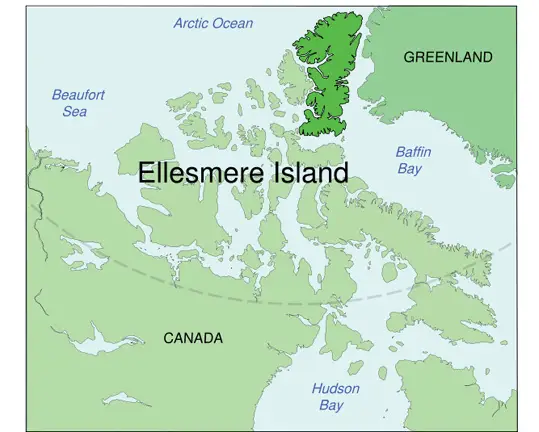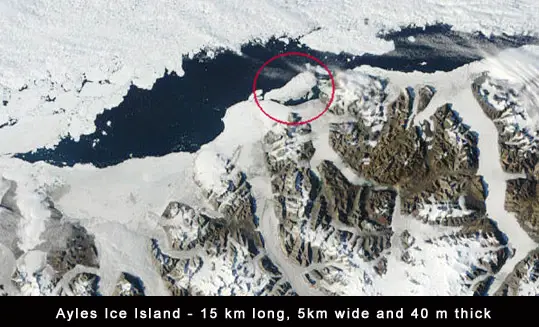Ellesmere Island Ayles Ice Shelf
Ellesmere Island is part of the Qikiqtaaluk Region of the Canadian territory of Nunavut. Lying within the Canadian Arctic Archipelago it is considered part of the Queen Elizabeth Islands, with Cape Columbia being the most northerly point of land in Canada. It comprises an area of 196,235 km² (75,767 square miles), making it the world’s tenth largest island and Canada’s third largest island.
Large portions of Ellesmere Island are covered with glaciers and ice, with Manson Icefield and Sydkap in the south; Prince of Wales Icefield and Agassiz Ice Cap along the central-east side of the island, along with substantial ice cover in Northern Ellesmere Island. The northwest coast of Ellesmere Island was covered by a massive, 500 km long ice shelf until the twentieth century.

Ellesmere Island Ice-Shelf Breaks Off
An enormous ice shelf broke off Ellesmere island in the Canadian arctic, the largest break up of its kind in 25 years. Assistant Professor Luke Copland, from the University of Ottawa, who reconstructed the events from seismic readings and satellite images, said “On August 13, 2005, almost the entire Ayles Ice Shelf calved from the northern edge of Ellesmere Island. This … continues a trend of dramatic loss of these ice shelves over the past century. Since 1900, approximately 90% of the Ellesmere Island ice shelves have calved and floated away.” The breakup was so powerful, earthquake monitors 250 kilometres away picked up the tremors as the 3,000 to 4,500 year-old shelf tore away from its fjord on Ellesmere.

Scientific director Louis Fortier of Canadian Artic research network ArcticNet says the massive break-off signals a rise in Arctic warming. “The break-up of the ice cover on Ellesmere Island has been going on for 12,000 years, but it seems to have accelerated in recent years which is another indicator, among many others, of warming of the entire Arctic cryosphere.” The Ayles Ice Shelf was one of six ice shelves left in Canada, remnants of a vast icy fringe that used to cover the top end of Ellesmere. Scientists consider the Canadian shelves, located about 800 kilometres south of the North Pole, sentinels that reflect the accelerating change in the Arctic.
The Ellesmere Island Ayles ice shelf (now island) may end up drifting into the Queen Elizabeth Islands or it may make it all the way to the Beaufort Sea. If the ice island were to reach the Beaufort Sea, it could become a problem for shipping and oil platforms.
See Also
